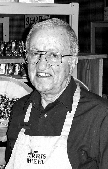 | The Farha’s, born and raised in Wichita, have spent their entire lives in the Food Business. Farris started in Farha Bros. Super Markets, then to F&E Wholesale Food Service, both family owned businesses. He spent 10 years with Pizza Hut (1969-1978) as V.P. of Administration and a member of the Executive Committee. A graduate of W.S.U., his only extended time away from Kansas was his military service in the Far East. Karen, too, was raised in the family food business, Cox Produce of Wichita. After Sterling College she managed the Dodge City division and eventually purchased that operation under the name of Cox Food Service. She later sold the company to F&E Food Service and assumed the position of Purchasing Manager and Executive Committee Member until F&E was acquired in 2005. In March of '06 the Farha’s opened The Farris Wheel, an old-fashioned candy, nut and gift shop. |
Candy, Chocolate & Sweets
2007-02-01 13:17:00
What is the origin of candy?
ANSWER: One of the phrases a toddler first learns is, “give me candy.” Years ago an Arab child might have asked for “gandi” because it comes from gand, meaning a lump of sugar. An Old Italian child would have requested “zucchero candi,” while in Old French it would have come out “sucre candi.” Looking back to Middle England we find it spoken of as “sugre candi” while in the 1800’s Americans called it “sugre candi.” Nowadays children just say “candy.” However, when we talk about candy today, we don’t mean only delicacies made from pure-sugar, but we also include other treats which combine sugar or similar sweeteners with fruits, nuts, and/or chocolate. It is probably no surprise that the favorite type of candy is chocolate.
I remember stories from my friends about them taking their younger brothers and sisters to the old-fashioned candy store. One of them talks about taking her youngest brother who was a mere toddler on the short walk there and encouraging him to choose the two for a penny candy. She talks with pride about giving him one piece, and guess who got the other piece? The little guy never knew any difference. Such a tactic probably wouldn’t fly today, however, since toddlers can even operate computers and thus could surely figure out they should get both pieces of candy. I have another friend’s wife who talks about her grandmother giving the children their Monday nickels, which, of course, would be spent at the corner candy store. Favorites from back then include Boston baked beans, Necco wafers, candy cigarettes, wax soda pop bottles, red wax lips, Bubble gum cigars, candy buttons, banana and chocolate BB bats, big sticks of taffy, Kits chews, Lolly pops, fireballs, and on and on. In reminiscing, I can’t even get those sweet thoughts out of my mind.
Americans today enjoy almost 25 pounds per person of sweet treats each year. One of the first times candy was used as a gift idea was in 1868 when the famous Cadbury chocolates were first introduced as a way to celebrate Valentine’s Day. A couple of other bits of trivia which you might find interesting. The famous Tootsie Roll candy was named by Leo Hirshfield of New York after his daughter’s nickname, “Tootsie.” While most people think about the Baby Ruth candy bar being named after the famous baseball player, it was, in fact, named in 1920 for the daughter of President Grover Cleveland.
Now the following should make you smile. Candy is considered a food per the U.S. Department of Agriculture’s “Food Pyramid.” You will remember there is a small triangle at the top of the pyramid which says “fats, oils, & sweets, use sparingly.” In accordance with its recognized nutritional value, candy’s calorie content does offer beneficial food value. This is because some candies contain milk, nuts, or fruit as part of the calories. Because calories are used by the body for energy, the calories in candy cannot be considered either “good” or “bad” but just a simple unit of heat measurement.
Sit back now and enjoy those visions of sugar plums dancing in your head not just at Christmas but at Valentine’s Day and all the year through.


